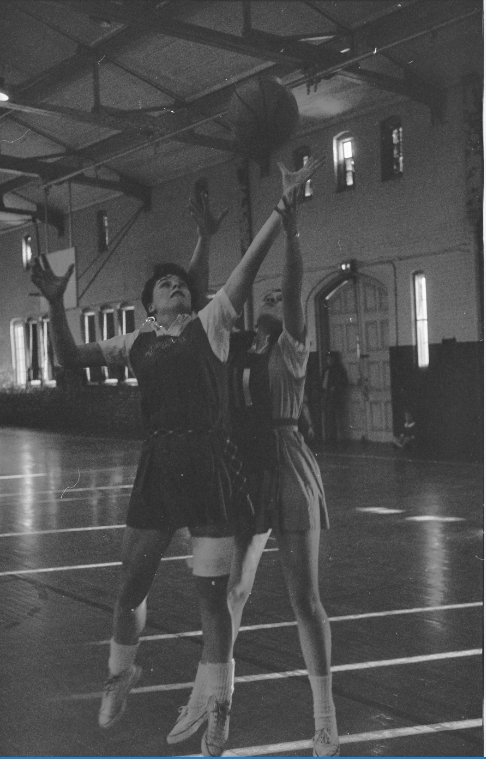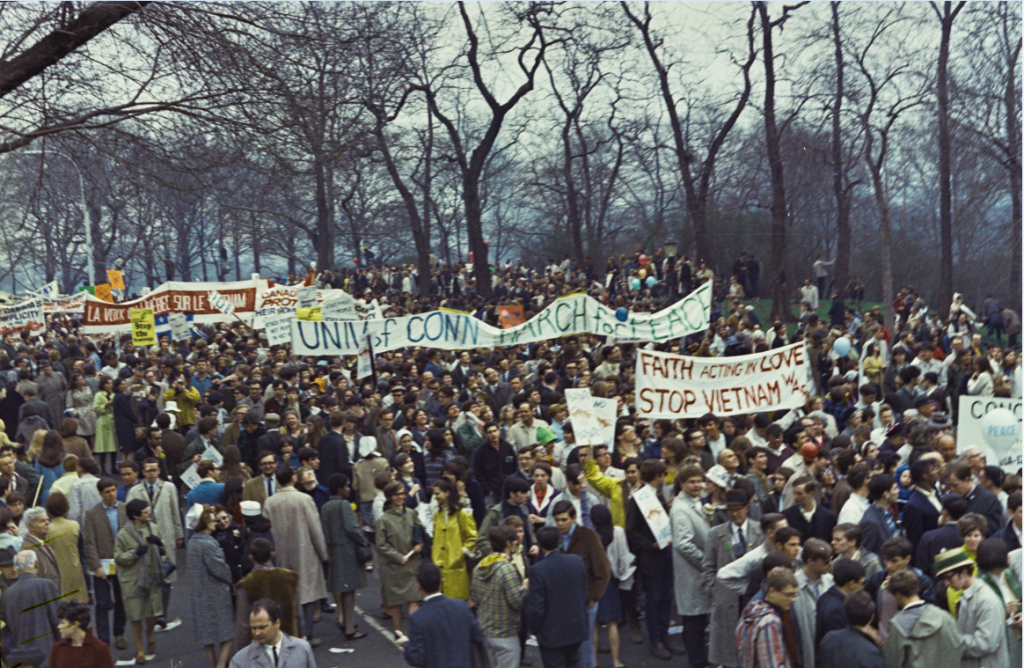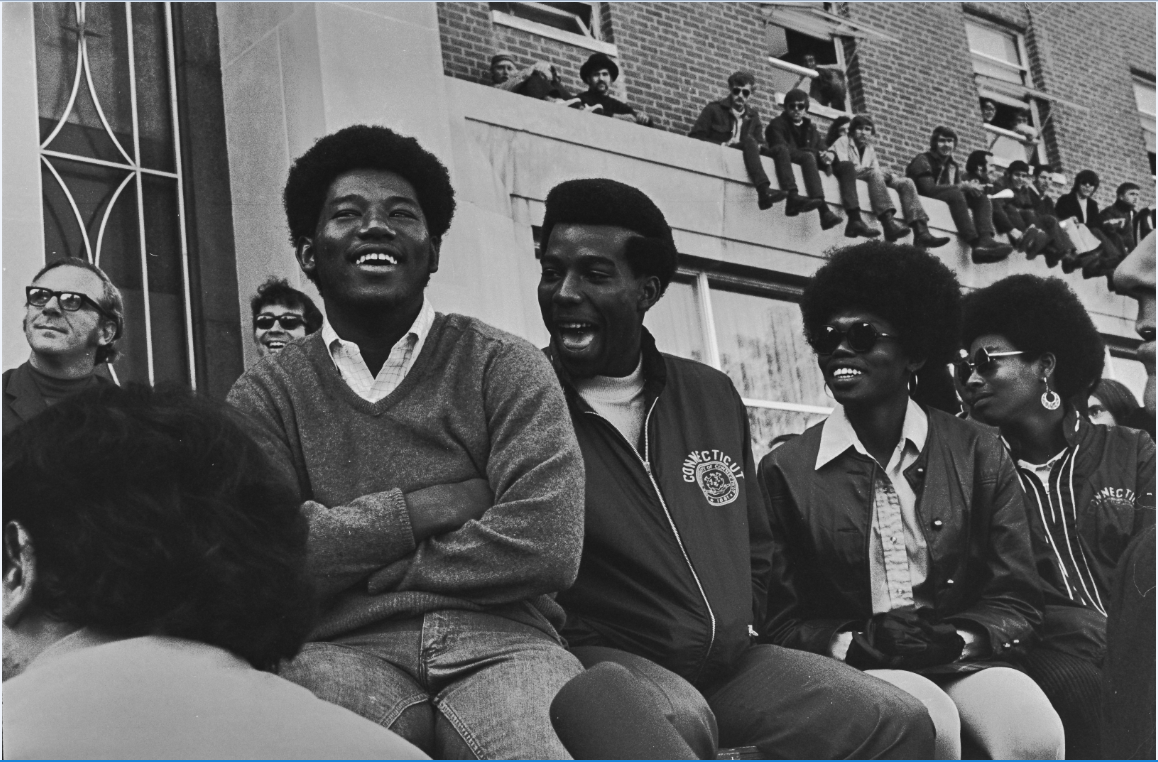Student newspapers have chronicled the life and times of their colleges and universities for decades, and UConn’s is particularly long-tenured: UConn’s student newspaper dates back to 1896, when The Lookout was first published at what was then known as Storrs Agricultural College. Fifteen years later, the newspaper was renamed The Connecticut Campus and continued to publish after the University of Connecticut was established in 1939. It moved to daily publication in 1955, and has produced five issues a week during the academic year ever since.
Photography, primarily publicity photos, began to appear in the campus newspaper as early as 1917 and by the 1950s, news coverage included photos of campus events such as student elections and Huskies basketball games. When Howard Goldbaum arrived on campus in 1965 with his camera, the newspaper’s coverage began to reflect both student life on campus and the turbulence of the times.
As a staff photographer and then photo editor for the newspaper, Goldbaum took hundreds of photos during protests against racism and the Vietnam War, campus traditions such as Homecoming, UConn athletics, and renowned performers and musicians who appeared in Storrs. Some of these images, drawn from Goldbaum’s extensive archive at the University, are included in a new exhibit called “UConn Through the Viewfinder: Connecticut Daily Campus Photographs from the Howard Goldbaum Collection, 1967-70” at the William Benton Museum of Art through March 13.
“It was a time of change. Revolution was in the air, as the song said,” says Goldbaum, who went on to serve as chief photographer at “El Vocero” in Puerto Rico and as a freelance photographer for Newsweek and other publications before becoming a journalism professor at Bradley University, where he was founding director of its multimedia program. Since 2003, he has taught at The Reynolds School of Journalism at the University of Nevada-Reno, where he is an associate professor of immersive media.

Goldbaum, who earned his degree in English at UConn before completing a master’s degree in communications photography from Syracuse University, says his time at the student paper shaped his future both in journalism classes and by working with student editors that included Juliet Cassone, Richard Cohen, Dennis Hampton, Al May, and Michael Whalen.
“I was learning that I was not just attracted to photography, I was attracted to where the action was. I wanted to be part the pivotal events of the time,” he says. “A lot of my career choices were influenced by mentors I had, particularly Evan Hill and John Breen of the journalism department. It was my close relationship with them that modeled my wish to become a journalism professor myself. John Breen was the faculty member who did the weekly critique with Daily Campus staff. I really loved his attitude. The way he gently chided us when we made mistakes was an inspiration for me, because later at Bradley University I became that person who did the weekly critiques with the newspaper staff at the Bradley Scout. Evan Hill was a unique professor. I looked up to him as a very wise voice and mentor in journalism education.”
The exhibition includes prints made from the hundreds of 35mm film negatives Goldbaum created during his time at The Daily Campus. The images include “Protest: Symbolic and Otherwise,” in which demonstrators are shown protesting the denial of tenure to a faculty member who was involved in anti-war protests; “Dancers Captivate Audience,” from a performance by the Alvin Ailey American Dance Theater; “Warming Hut Demonstration,” depicting UConn students protesting the Vietnam War in 1967 and 1968; a 1967 performance by Ravi Shankar, the classical musician from India who introduced the sitar to George Harrison of The Beatles; and “Watch That Elbow,” from a women’s basketball game against Springfield College in 1969, described as “Action in a girl’s basketball game.”
Part of the exhibition focuses on the process of photography before the age of digital cameras. There are contact prints — a page with 35mm images of all photos on a single roll of film — with marks indicating which images would selected for use in the newspaper, along with the manila envelopes into which they were placed, identified by date and news assignment.
In a room off the Benton’s Center Gallery where the exhibit is displayed, visitors can see an even more vivid demonstration of pre-digital photography: a darkroom with chemical trays, a photo enlarger, and a drying wire with clothespins holding photo prints. There is also the characteristic smell and sounds of the college newspaper darkroom from that era–the odor of the chemicals used to make prints, and rock music. The only missing elements photographers from that era might notice are ashtrays used for incense and cigarettes, along with a rolled up towel at the bottom of the door to keep the sometimes clandestine smoke from spreading beyond the walls of the darkroom.
Goldbaum says documenting events on campus such as anti-war protests reflected the evolving lifestyles of the times.
“People were rebelling against the war but it metastasized into rejecting many of the class norms between freshman and seniors and the interactions between men and women,” he says. “It was a revolution of students demanding more independence, more control over their lifestyle, whether it was the ability to grow your hair long or to visit women in the dormitories at any hour. I was in the UConn Honors program and we did away with grades after our freshman year.”
The experience of being a photographer on the frontline of events fed his enthusiasm for finding a way to remain there.
“It always made my pulse beat faster,” Goldbaum says. “I didn’t want to miss any of the action because of the ability of photojournalists to get to places maybe off limits to others. I was able to use my student credentials, and then later working as a professional photojournalist in Puerto Rico and elsewhere, [to stay] on the frontlines of conflict and political change.”
Goldbaum also has stayed on the leading edge of technology in his field. He started taking photos with a twin-lens camera using 2 ¼ film but moved into 35mm film photography early as a freelancer. While teaching at Bradley, he began to use the early Apple digital cameras and created one of the first classes in digital photography.

Over the last decade in Nevada, he has moved his photography into virtual reality projects with websites that allow visitors to explore historic sites including ancient monuments of Ireland, a 17th century Jacobean home and estate in England, and various locations around Nevada. All of these projects can be accessed via his website.
“UConn Through the Viewfinder: Connecticut Daily Campus Photographs from the Howard Goldbaum Collection, 1967-70” continues through March 13 at the William Benton Museum of Art. For more information, visit the Benton’s website.



